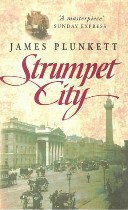 James Plunkett •
James Plunkett •
Strumpet City •
Take this book with you on a cross-country flight and settle in for a good, satisfying read. The plane will reach its destination long before you’re ready to leave Dublin.
Strumpet City opens with King Edward VII’s visit to Ireland in 1907, and the reactions it inspires among the inhabitants. Mary, a housemaid, simply enjoys the spectacle. Fitz, her young man, spends the day working at his foundry job. Cook bristles at the mere mention of the English and laments the loss of her Fenian father and his like. (“There was men for you. Not like what’s going nowadays.”) Mr. Bradshaw, a retired civil servant, worries that reverberations from the artillery salute will damage the rickety waterfront dwellings he owns.
And Rashers Tierney, who beds down on rags in the basement of such a tenement, hopes to sell patriotic ribbons to earn a few shillings for food. His neighbor comments that the Irish green doesn’t match well with British colors. “It never did, ma’am,” says Rashers. “Isn’t that what all the bloody commotion is about for the last seven hundred years?”
This cast, supplemented by a charismatic labor leader, a lady of the evening, and a houseful of priests, provides a window into every corner of Dublin society from a hundred years ago.
Strumpet City enjoyed enormous success at the time of its publication but has been largely forgotten since—a terrible shame. Plunkett’s sure touch never wavers, whether he’s depicting a workers’ strike, a refined musical evening, or the banter in pubs. Every scene is both historically accurate and emotionally honest, and the story’s flow carries you along like a river.
If you want to know Ireland and the Irish, you can’t find a better introduction than this sweeping epic told through everyday scenes.






Your email address will not be published.